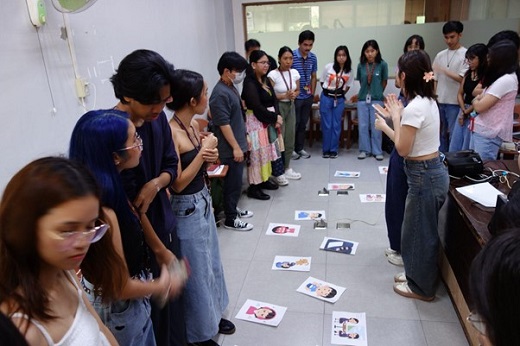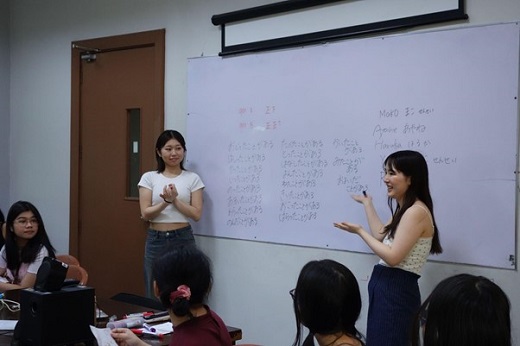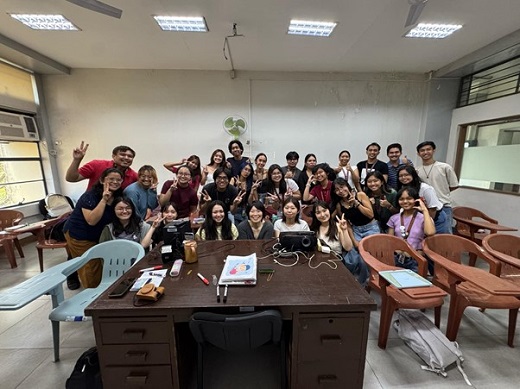[School of Global Japanese Studies]Cross-border Learning Connected by Art-based Research - From Kishi Seminar's Fieldwork in the Philippines
Apr. 18, 2025



The Kishi Seminar is engaged in art-based research. As part of this approach, NANJYO Ayane and SATO Haruka, third-year undergraduate students, taught a Japanese language class at the University of the Philippines in March, 2025. They implemented a class that utilized visual art to help students learn and use Japanese grammar while having fun. The lesson method received high praise from the local Japanese language teacher, Ms. Leah, who decided to continue using the developed teaching materials in future classes. The following is a report from Ms. NANJYO, who planned, developed, and implemented this program.
▶︎ NANJYO Ayane (3rd year student, Kishi Seminar)
I went on a fieldwork trip to the Philippines in March to observe practices that implement education and research using art methods and exchanging opinions with researchers and practitioners. Before the Arts-based Research and Learning Forum scheduled for the afternoon, I was asked to visit a Japanese language class and give a lesson using the sentence pattern “I have done …” using the art method. I received this request only three days before the trip, but based on our previous experience, together with Ms. Sato, we prepared a class that would be fun with the students.
On the day of the class, we felt the possibility of exploring while playing. We prepared a variety of illustrations expressing “I have done….” We used free illustrations to create a Karuta. Students look at the illustrations and make sentences using the sentence pattern “I have done…before.” Speaking and listening to “I have done” over and over again helps them memorize the grammar, and since the sentences reflect their interests and daily life, it also helps them understand others and their culture. At first, we played “I have done” in a Karuta format to have them experience listening well while having fun (Photo 1). We read out example sentences using the sentence pattern and ask the students to take picture cards of situations that match the sentences. For example, “I have listened to Japanese music” or “I have eaten sushi.” Students take the illustrations that the words indicate. They look at the illustrations seriously in a circle and take the cards quickly when they hear our voices. The students were so competitive that Karuta cards fell apart.
After playing Karuta, we sat in a circle again and did an activity in which we used our own picture cards to create our example sentences using that sentence pattern. For example, through sentences such as “I have listened music of …” and “I have done … in Japan,” we and the students were able to learn about each other's experiences and daily lives.
In the afternoon, we exchanged case studies with researchers and students working on Art-Based Research (ABR) at the University of the Philippines Open University through the Arts-based Research and Learning Forum. We also introduced the ABR practices we are working on in the Kishi Seminar and had a lively exchange of opinions. We also visited PETA (Philippine Educational Theater Association), an educational theater organization established in the Philippines in 1967, and participated in a workshop for high school students, and visited Gian's laboratory at the University of the Philippines Los Banos. The “bahay-bahayan” is an educational program that allows students to play and learn by embedding drama in their daily lives. The story progressed without my knowing what would be going to happen next, and I had the sense that my body was naturally drawn into it and moved with it. Instead of seeing things from someone else's point of view as an audience member, I was naturally able to think about things from my point of view by being involved on the stage. The word “bahay-bahayan” means “to play” in Filipino. I felt that through playing, taking things as one's own, and considering the situations of others while playing, one has the potential to explore various issues in the world, such as historical events, gender issues, mental health issues, and political issues. From this fieldwork, I could sense that this playful approach to learning and exploration through art methods has the potential to draw out learners' interest and promote independent learning.
It was very meaningful to be able to share and discuss case studies on ABR with the University of the Philippines and PETA during this fieldwork. These experiences will be very useful for my future research in the seminar. I would like to continue to have opportunities to share and further develop our practices and research in such an international setting. Thank you very much to Dr. Rob and Dr. Leah from the University of the Philippine and to everyone in the Guian lab!
≪Japanese version≫
▶︎ NANJYO Ayane (3rd year student, Kishi Seminar)
I went on a fieldwork trip to the Philippines in March to observe practices that implement education and research using art methods and exchanging opinions with researchers and practitioners. Before the Arts-based Research and Learning Forum scheduled for the afternoon, I was asked to visit a Japanese language class and give a lesson using the sentence pattern “I have done …” using the art method. I received this request only three days before the trip, but based on our previous experience, together with Ms. Sato, we prepared a class that would be fun with the students.
On the day of the class, we felt the possibility of exploring while playing. We prepared a variety of illustrations expressing “I have done….” We used free illustrations to create a Karuta. Students look at the illustrations and make sentences using the sentence pattern “I have done…before.” Speaking and listening to “I have done” over and over again helps them memorize the grammar, and since the sentences reflect their interests and daily life, it also helps them understand others and their culture. At first, we played “I have done” in a Karuta format to have them experience listening well while having fun (Photo 1). We read out example sentences using the sentence pattern and ask the students to take picture cards of situations that match the sentences. For example, “I have listened to Japanese music” or “I have eaten sushi.” Students take the illustrations that the words indicate. They look at the illustrations seriously in a circle and take the cards quickly when they hear our voices. The students were so competitive that Karuta cards fell apart.
After playing Karuta, we sat in a circle again and did an activity in which we used our own picture cards to create our example sentences using that sentence pattern. For example, through sentences such as “I have listened music of …” and “I have done … in Japan,” we and the students were able to learn about each other's experiences and daily lives.
In the afternoon, we exchanged case studies with researchers and students working on Art-Based Research (ABR) at the University of the Philippines Open University through the Arts-based Research and Learning Forum. We also introduced the ABR practices we are working on in the Kishi Seminar and had a lively exchange of opinions. We also visited PETA (Philippine Educational Theater Association), an educational theater organization established in the Philippines in 1967, and participated in a workshop for high school students, and visited Gian's laboratory at the University of the Philippines Los Banos. The “bahay-bahayan” is an educational program that allows students to play and learn by embedding drama in their daily lives. The story progressed without my knowing what would be going to happen next, and I had the sense that my body was naturally drawn into it and moved with it. Instead of seeing things from someone else's point of view as an audience member, I was naturally able to think about things from my point of view by being involved on the stage. The word “bahay-bahayan” means “to play” in Filipino. I felt that through playing, taking things as one's own, and considering the situations of others while playing, one has the potential to explore various issues in the world, such as historical events, gender issues, mental health issues, and political issues. From this fieldwork, I could sense that this playful approach to learning and exploration through art methods has the potential to draw out learners' interest and promote independent learning.
It was very meaningful to be able to share and discuss case studies on ABR with the University of the Philippines and PETA during this fieldwork. These experiences will be very useful for my future research in the seminar. I would like to continue to have opportunities to share and further develop our practices and research in such an international setting. Thank you very much to Dr. Rob and Dr. Leah from the University of the Philippine and to everyone in the Guian lab!
≪Japanese version≫


